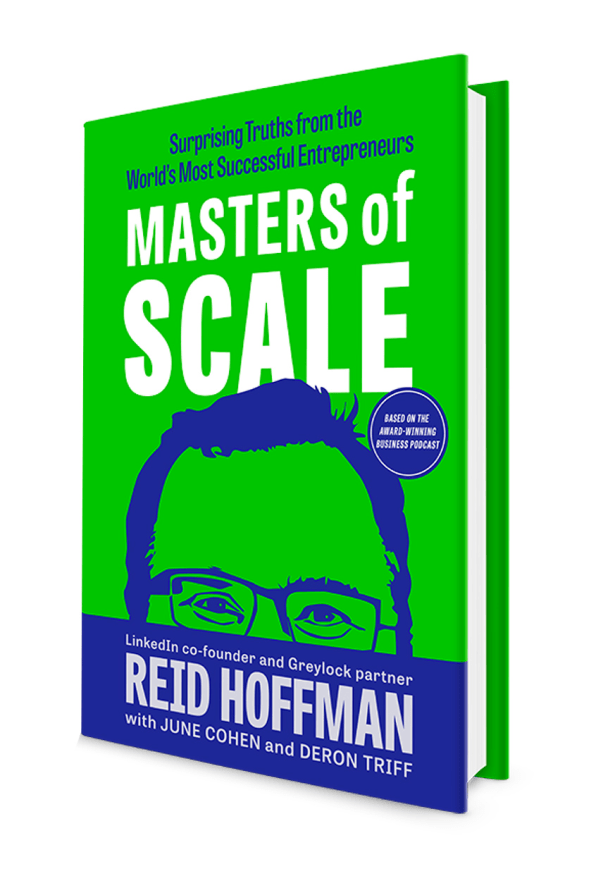These eight ‘Masters of Scale’ built multibillion-dollar companies by asking simple, but important, questions.
Is questioning the starting point of innovation?
That’s a question I explored at length in my 2014 book, A More Beautiful Question, wherein I chronicled breakthroughs over the years that began with someone asking a question. It turns out game-changing questions led to the internet, instant photography, Gatorade, the International Red Cross, Netflix, and much more. (For those who are interested, some of those origin stories are briefly recounted here).

But it was still surprising to learn—as I did from Reid Hoffman’s new book, Masters of Scale: Surprising Truths From the World’s Most Successful Entrepreneurs—how many of today’s top Silicon Valley entrepreneurs are inveterate questioners, driven by curiosity. While tech founders are sometimes stereotyped as hyper-driven people who scarcely pause to breathe, let alone to reflect or question anything, the Masters of Scale book’s interwoven portraits of dozens of startup leaders (many but not all from the tech world) show that the process of scaling a business idea is rife with complexities, contradictions, and uncertainties. To navigate the challenge, you need to be a restless learner and a person who’s not afraid to question anything—including your own bright ideas.
The book, based on the Hoffman-hosted popular podcast of the same name, is coauthored by Hoffman with June Cohen and Deron Triff (who helped scale TED Talks before launching the multimedia company WaitWhat, producer of the Masters of Scale podcast). Disclosure: I consulted with the authors during the early stages of producing the Masters of Scale book, which led me to do a deep dive into Hoffman’s recorded conversations with the featured entrepreneurs.
Those conversations are primarily focused on the practical nuts and bolts of launching a new business venture and enabling it to grow rapidly—encompassing everything from how to raise venture capital funding to how to hire the right people. But what stands out most is the passion behind the process. These founders convey a genuine sense of wonder about the world as it currently exists and the possibilities to bring about change.
As the book shows, entrepreneurialism all starts with “the big idea,” and the ideas that drove so many of the Masters of Scale (hereafter MOS) startups came out of the founders’ real-world experiences and frustrations. And those ideas tended to take shape, at least initially, as a question or set of questions. As in, Why does problem X exist? What if we tried doing Y to solve it? As their businesses launched and grew, the challenges—and the questions—tended to grow and become more complex.
What do some of those questions look like? Below is a sampling of what the MOS founders asked themselves as they launched and grew their businesses—a quick primer on the art of asking questions that spark innovation. Some of these questions may seem obvious in hindsight, but no one else was asking them at the time.

WHITNEY WOLFE HERD OF BUMBLE
Reacting to her own unsatisfying experiences with online dating services (she’d previously worked on the dating app Tinder), Herd started with a simple diagnostic question: What’s broken in online dating? She felt it just wasn’t working for women, who had little control over online interactions with men and sometimes ended up getting harassed. This led to Herd’s ambitious follow-up question: What if only women could initiate the conversation? She then designed Bumble so that with any potential match, women always got to make the first move. Herd’s two-step questioning approach is classic: Start by inquiring about a large, systemic problem, then proceed to a bold, imaginative what-if question that proposes a possible solution.

DANIEL EK OF SPOTIFY
Here’s another example of a similar “one-two” questioning approach. When he was young, Ek had been a fan of Napster, but as a musician himself he understood why music piracy didn’t work as a business model. So his initial question was, Why hasn’t anyone made a version of Napster that works for both consumers and artists? To do that you’d have to design an online music streaming service that rewarded the content producers; to that end, Ek worked directly with record companies to strike deals with their artists. But he also had to capture the fancy of consumers, and as he set out to do that he was guided by this question: What if we could build something that makes it feel like you had all the world’s music on your hard drive? To achieve that, Ek had to ensure that Spotify provided a massive offering of music, delivered at near-immediate download speeds, and customized to listener preferences.

JENN HYMAN OF RENT THE RUNWAY
For those wondering where to look for a problem that can spark a great question, the answer is . . . anywhere. Hyman happened to be looking in her clothes closet, where it seemed just about everything was old and outdated. Which prompted this question: Why is it that we have a closet that’s a museum to who we once were? In pondering that question, she came up with this second one: What if the closet were a living, constantly changing thing? The way to practically and affordably do that would be to rent, not buy, the clothes in your closet. Hyman’s online site made it easy to rent the latest, most fashionable apparel, and the idea made sense not only for cost-conscious customers, but also for clothing suppliers—who now had a whole new market available to them.

EV WILLIAMS OF TWITTER AND MEDIUM
As Hoffman explains in the book, Williams has been pursuing some version of the same question for years, as he has had a hand in launching first Blogger, then Twitter, and then Medium. The overriding question: What’s preventing people from sharing thoughts online? Williams’s attempts to answer that have taken the form of blogging, tweeting, or longer-form online writing. The key takeaway here is that if you take ownership of a big enough question, and adapt it to different markets or situations, it can spawn multiple answers and opportunities over the years.

SARA BLAKELY OF SPANX
Blakely invented Spanx by questioning the way women’s pantyhose were designed; specifically, she famously cut off the feet of her own pantyhose and subsequently launched a billion-dollar company around that creation. But the question featured below is one that Blakely began asking after she launched her company, as she was starting to scale it and wanted to encourage creativity in her staff. Blakely’s question was: If no one showed you how to do your job, how would you do it? That question continues to guide the way she manages the people who work for her—encouraging them to learn, experiment, and bring their own ideas into the mix.

DANNY MEYER OF UNION SQUARE HOSPITALITY
The famed restaurateur shared the same concern as many other MOS in the book: How does one maintain a strong company culture while growing rapidly? But that’s a mundane, rather uninspiring question. It gained new force when, at the suggestion of consultant Erika Andersen, Meyer flipped that question to this one: How can we use growth to advance our culture? As Meyer realized, culture can’t really be “maintained” anyway—it’s a living force that’s bound to change. But Meyer could leverage the company’s growth to invest more in culture—by creating more incentives for employees and putting more resources into clearly articulating and spreading cultural values throughout the organization. The lesson: Questions can become more powerful when you turn them upside down or flip them sideways, particularly if you can turn an ordinary question into a more provocative or inspiring one.

CATERINA FAKE AND STEWART BUTTERFIELD OF FLICKR
One of the surprises in the Masters of Scale book is seeing how many success stories were born out of failure. Just before launching the groundbreaking photo-sharing app Flickr, Fake and Butterfield were trying to get an online video game off the ground, with no luck. They had burned through funding and were about to give up when they asked themselves: Is there any way we can not go out of business? In his book, Hoffman refers to this as the question that “has launched a thousand pivots.” You hit a wall and then ask what can we still do with what we have? Fake and Butterfield had a video game no one wanted, but buried within that game was a feature that allowed you to drag, tag, and share photos. They killed the game and focused on that feature, which became Flickr.
For those trying to find their own beautiful question to pursue, here are a couple of final tips from Hoffman (who helped launch LinkedIn and PayPal, and now is an investor at Greylock Partners). He says too many would-be entrepreneurs are focused on the question, What’s the next big thing? If you lack a crystal ball, that’s a difficult question to answer. A better question tries to get at something only you can answer and that you care deeply about: What is my vision for the future, and how can I begin to realize that vision?
One final question that can be useful: If you think you’ve found your big idea and want to know what others really think about it, Hoffman recommends sharing the idea and then asking: What’s wrong with this idea? Don’t ask for encouragement—ask for criticism. “You want people to challenge and poke holes in your idea,” Hoffman says. “It’s better to find those holes before you bring that idea into the world.”
…
This article first appeared in www.fastcompany.com
Seeking to build and grow your brand using the force of consumer insight, strategic foresight, creative disruption and technology prowess? Talk to us at +971 50 6254340 or mail: engage@groupisd.com or visit www.groupisd.com/story



